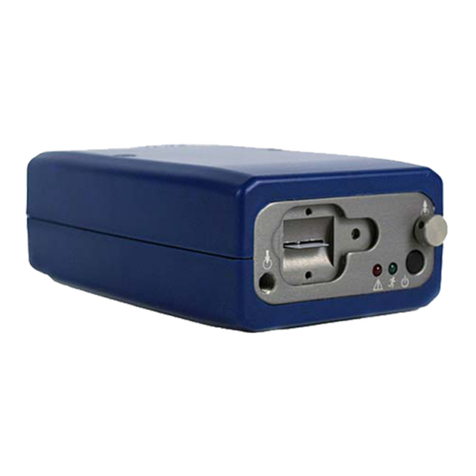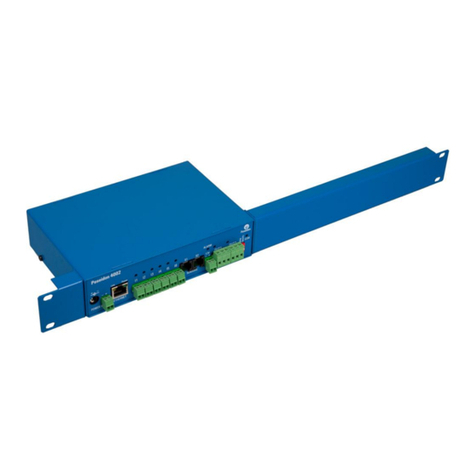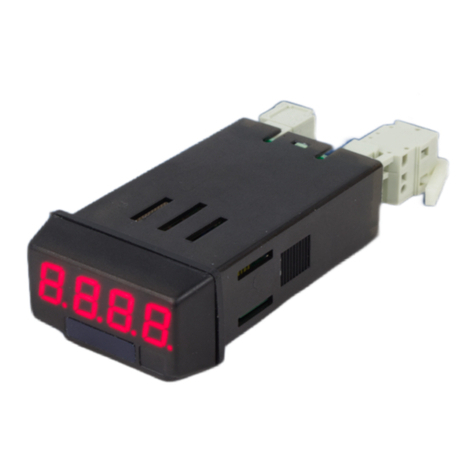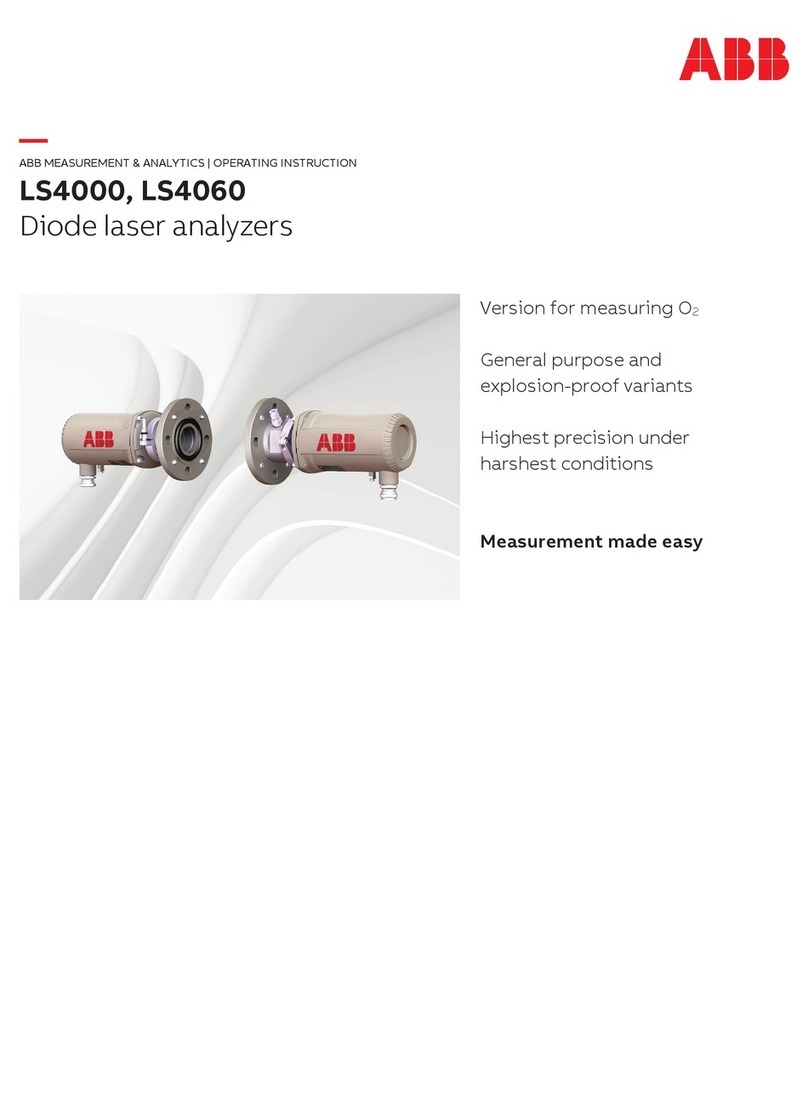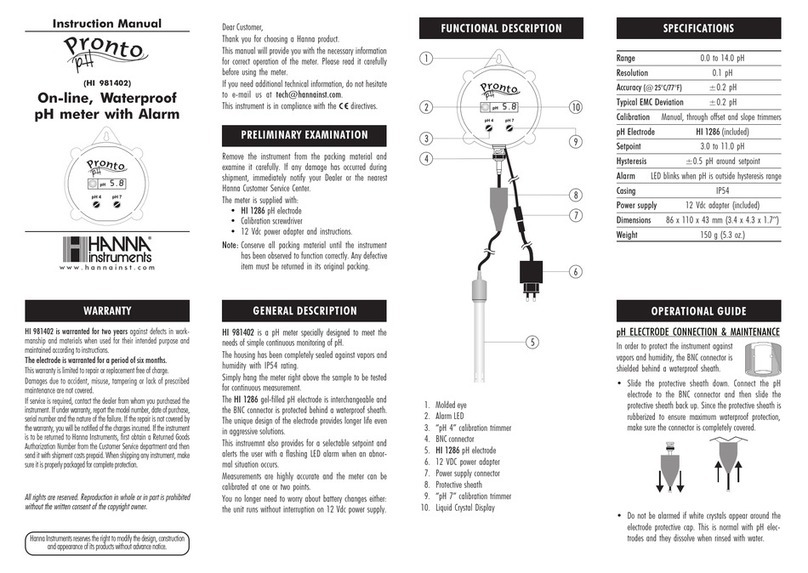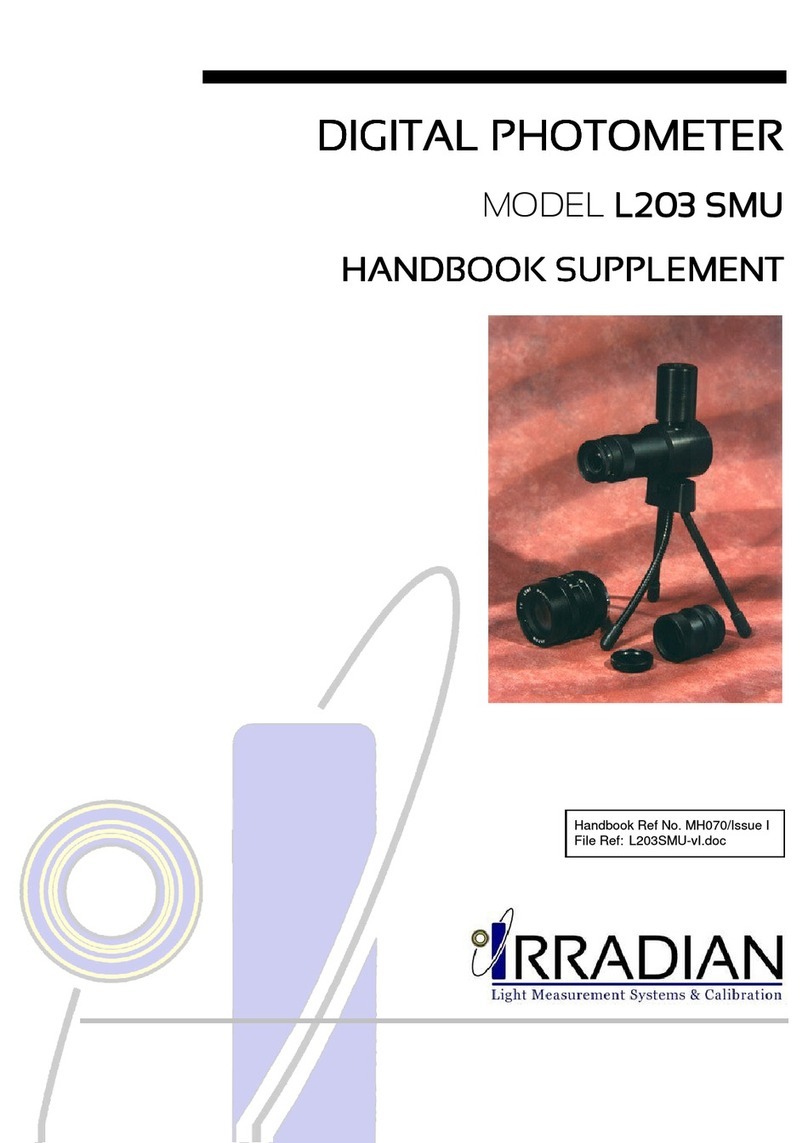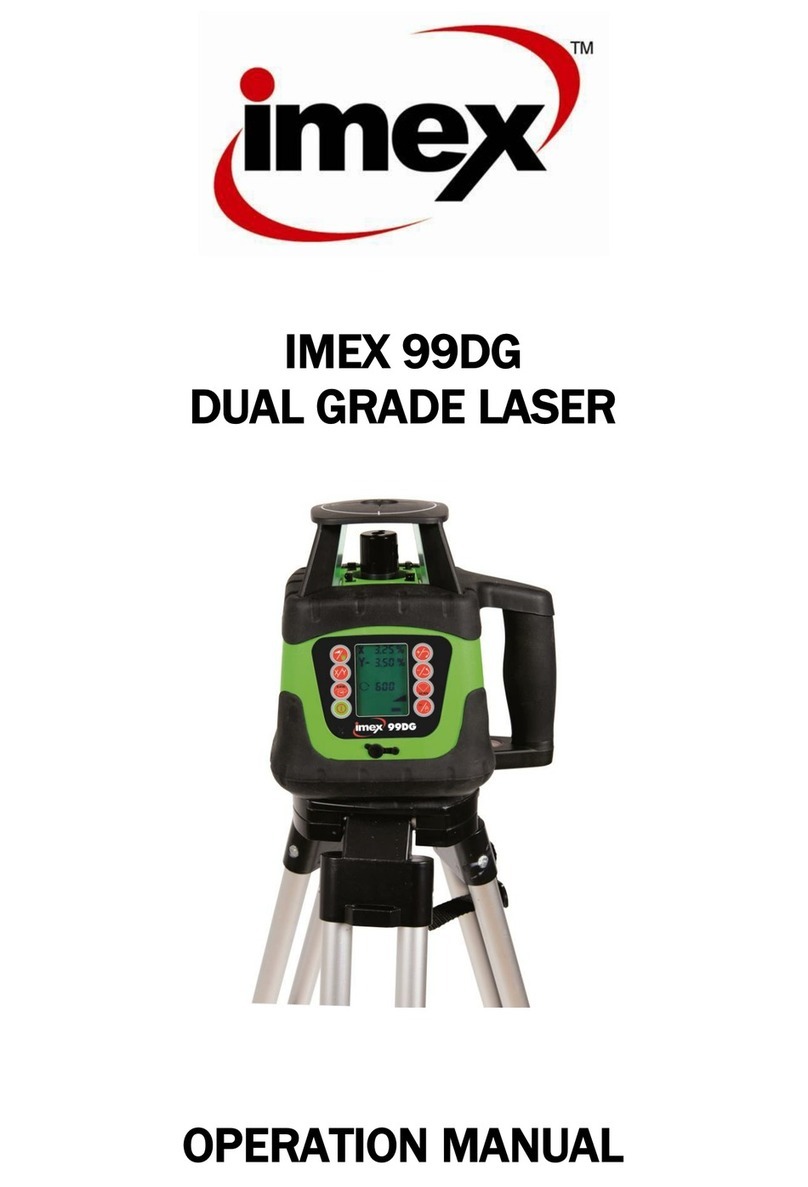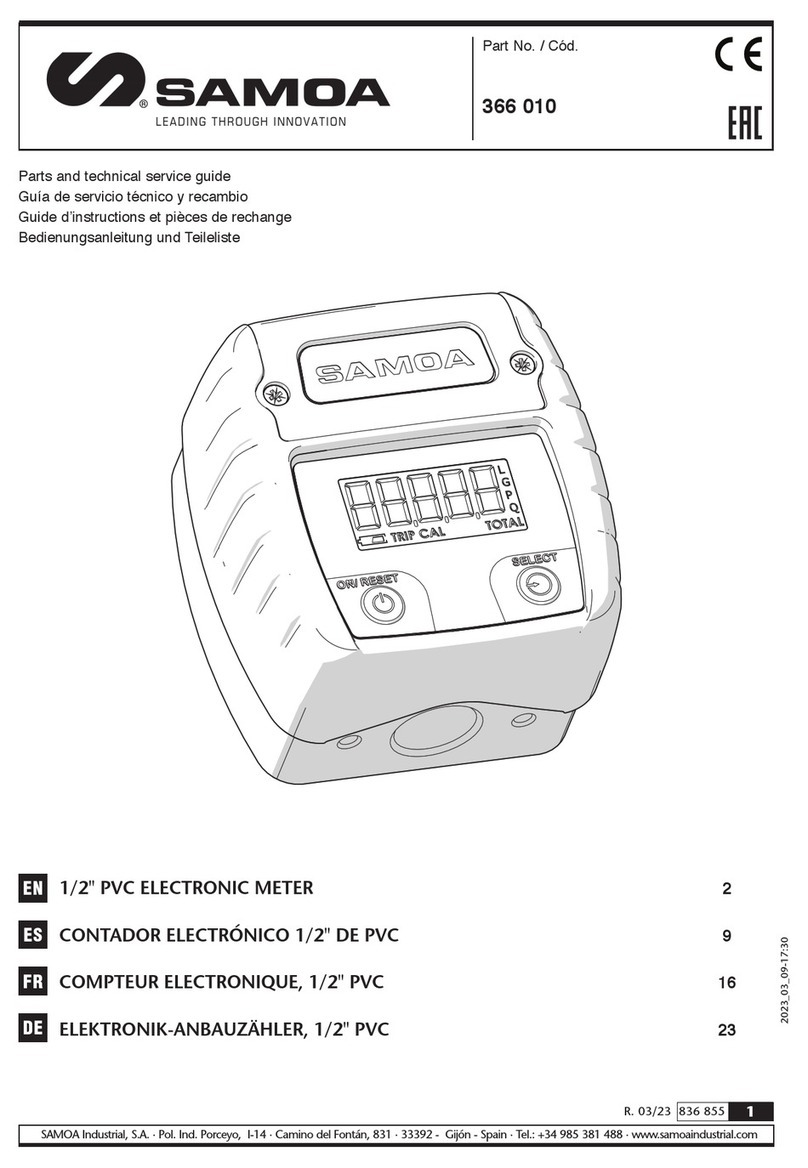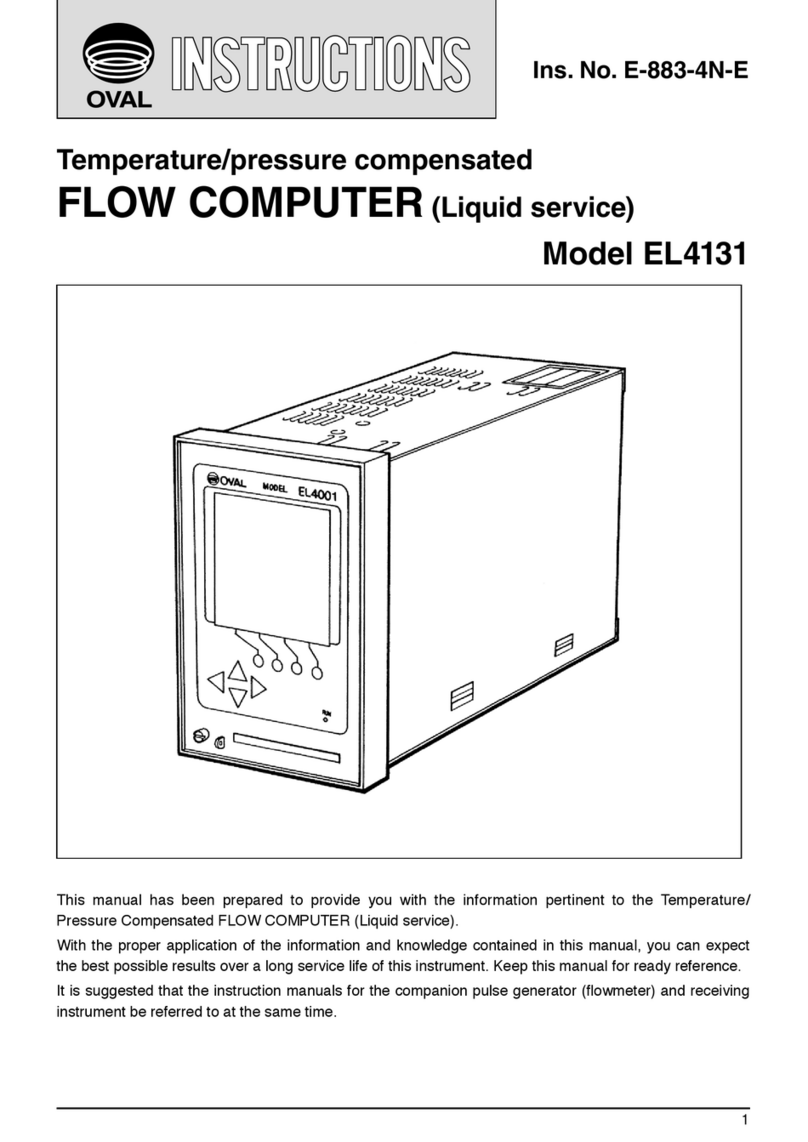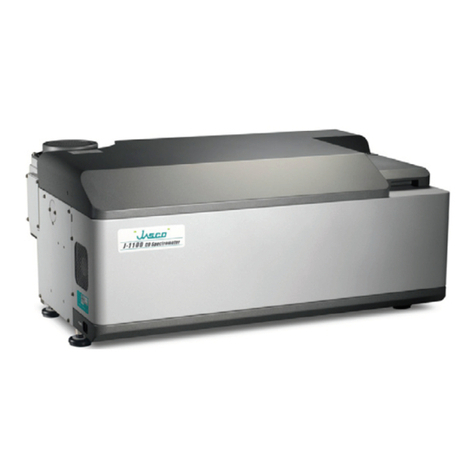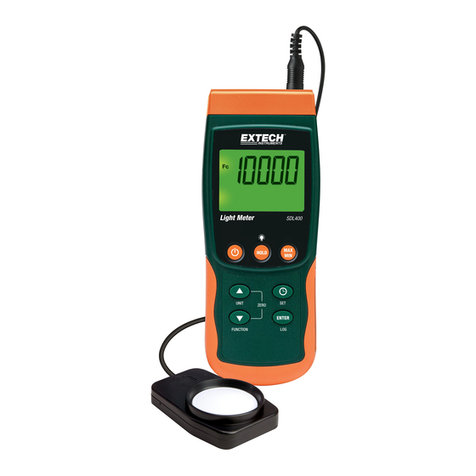Aethlabs microAeth AE51 User manual

https://aethlabs.com
© 2014 AethLabs
San Francisco, California
AethLabs
microAeth®Model AE51
Operating Manual

1. Introduction ..............................................................................................................................................4
1.1 Serial Number ..........................................................................................................................................4
1.2 Overview ..................................................................................................................................................4
1.3 Instrument Diagram .................................................................................................................................5
1.4 Technical Specications ..........................................................................................................................6
1.5 Symbols and Cautions ............................................................................................................................7
1.5.1 Explanation of Operation Symbols.................................................................................................7
1.5.2 Important Safeguards.....................................................................................................................7
1.5.2.1 Power Source ....................................................................................................................7
1.5.2.2 Object and Liquid Entry ....................................................................................................7
1.5.2.3 Accessories .......................................................................................................................7
1.5.2.4 Servicing ...........................................................................................................................8
1.5.2.5 Replacement Parts ............................................................................................................8
1.5.2.6 Other Warnings .................................................................................................................8
2. Conguration and Operation ..................................................................................................................9
2.1 Overview ..................................................................................................................................................9
2.2 Best Use Practices Recommendations ...................................................................................................10
2.2.1 Instrument Settings: Measurement TimeBase and Flow Rate .......................................................10
2.2.2 Recommended Settings of microAeth Model AE51 for Different Scenarios ..................................11
2.2.3 Contamination, Maintenance, and Cleaning of Sample Chamber .................................................12
2.3 Filter Media ..............................................................................................................................................13
2.3.1 General ..........................................................................................................................................13
2.3.2 Filter Strip Installation and Removal ..............................................................................................13
2.4 Power ......................................................................................................................................................14
2.5 microAethCOM PC Software Installation ................................................................................................ 14
2.6 Operation and Communication ...............................................................................................................16
2.6.1 microAeth Operation ......................................................................................................................16
2.6.2 Conguration of Instrument Operating Parameters .......................................................................17
2.6.2.1 microAeth Time & Time Sync ............................................................................................18
2.6.2.2 Flow Set Point ...................................................................................................................18
2.6.2.3 Timebase ...........................................................................................................................18
2.6.2.4 Operating Mode ................................................................................................................19
2.6.2.5 Shutdown Mode ................................................................................................................19
2.6.2.6 Sound Notications ...........................................................................................................19
2.6.3 Downloading Data ..........................................................................................................................19
2.6.4 Erasing Data ...................................................................................................................................20
2.6.5 Viewing and/or Analyzing Measurement Data ...............................................................................21
2.6.6 Data File Structure..........................................................................................................................22
2.6.7 Status Indications ...........................................................................................................................23
2.6.7.1 LED Status Indications ......................................................................................................23
2.6.7.2 Data File Status Codes .....................................................................................................23
2.7 Upgrading microAeth Operating System Firmware ................................................................................ 24
2.8 Manual Flow Calibration Procedure ....................................................................................................... 27
TABLE OF CONTENTS

microAeth®Model AE51 Operating Manual 5
AethLabs
4 microAeth®Model AE51 Operating Manual AethLabs
1.1 Serial Number
The model and serial number are located on the
back panel. Record the serial number in the space
provided below. Refer to these numbers whenever
you call for service.
Model No.: microAeth® Model AE51
Serial number: AE51-S__-_____-______
1.2 Overview
Real-time Aerosol Black Carbon Personal Exposure
Measurement Device
• Pocket-size, lightweight Aethalometer (250 g)
• Fast response: 1 second measurement timebase
• Low power consumption: 24 hour run time on
one charge
• Onboard data processing, logging and
diagnostics
• Flexible sampling options and wide dynamic
range
• Filter strips for accurate sample tracking
The microAeth Model AE51 is designed specically
for investigation of personal exposure to
carbonaceous particles found in ambient air. The
instrument is based on Aethalometer technology
that is widely used for studying indoor or outdoor
air quality, and for the mobile mapping of the air
quality impacts of localized sources. The instrument
provides high quality, short time resolved data
essential for assessing the real-time concentration of
Black Carbon aerosols in a micro-environment.
The package includes:
• microAeth Model AE51 Personal Exposure
Monitor
• Self-powered, LED source (880nm-IR), user-
selectable measurement timebase settings of 1,
10, 30, 60, 300 seconds, ow rate settings of 50,
100, 150, 200 ml/min with internal active mass
ow measurement and control
• Sample collected and analyzed on a lter strip
consisting of a T60 Teon coated borosilicate
glass ber media housed in a protective casing
• USB-based power charger with AC adapter
(100-500mA) for internal 5VDC lithium ion
battery.
• USB charging / interconnect cable
• Flexible conductive sample tubing (40 inches)
with swivel tube connector
• Pack of 5 sample lter strips
• CD containing
- microAethCOM communications software and
USB driver
- Operating Manual
• Quick Start Guide (hard copy)
For further information on this instrument or Black
Carbon measurement, please contact:
AethLabs
San Francisco, California
https://aethlabs.com
1. INTRODUCTION 1.3 Instrument Diagram
Inlet
Power button
Outlet
Running light (green)
Alert light (red)
Filter strip with locating pin
(behind cover)
Figure 1: microAeth front panel
Figure 2: Filter strip slot
Figure 3: microAeth rear panel
USB Port (behind cover)
Charge indicator light (yellow)
Serial number

6 microAeth®Model AE51 Operating Manual microAeth®Model AE51 Operating Manual 7
AethLabsAethLabs
1.4 Technical
Specications
Measurement Principle
Real-time analysis by measuring the rate of change
in absorption of transmitted light due to continuous
collection of aerosol deposit on lter. Measurement
at 880 nm interpreted as concentration of Black
Carbon (‘BC’).
Measurement Range
0-1 mg BC/m3, lter life time dependent on
concentration and ow rate setting:
avg. 5 µg BC/m3 for 24 hours @ 100 ml/min
avg. 100 µg BC/m3 for 3 hours @ 50 ml/min
avg. 1 mg BC/m3 for 15 min @ 50 ml/min
Measurement Resolution
0.001 µg BC/m3
Measurement Precision
±0.1 µg BC/m3, 1 min avg., 150 ml/min ow rate
Measurement Timebase (User setting)
1, 10, 30, 60, or 300 seconds
Flow Rate (User setting)
Internal pump provides 50, 100, 150, 200 ml/min,
monitored by mass ow meter and stabilized by
closed-loop control.
Sampling
3 mm spot created on lter strip containing insert of
T60 Teon-coated borosilicate glass ber lter material.
PM2.5 size selective inlet available.
Consumables
Filter strip: 1 lter strip per sampling event, typically
one per day.
Data Storage
4 MB internal ash memory, providing up to 1 month
data storage when operating on a 300 second
timebase, and 1 week when operating on a 60
second timebase.
Communications
USB connectivity to Windows®-based PC with
microAethCOM, or data stream via digital output
through mini USB port (command protocols can be
supplied).
Data Output
Internal data les are uploaded to microAethCOM
PC software and stored on local disk.
PC Software
microAethCOM software is included. Provides visual
interface including real-time BC mass concentration
values. Facilitates settings conguration, calibration
routines, downloading data, and uploading new
instrument rmware.
Dimensions
4.6 in (117 mm) L x 2.6 in (66 mm) W x 1.5 in
(38 mm) D
Weight
Approximately 0.62 lbs (280 g).
Power
Internal rechargeable lithium-ion battery.
Power Supply Adapter
Input: 100~240 VAC 50/60 Hz 0.2 A
Output: 5VDC / 0.5A
Charging Time
4 hours to full charge (using AC adapter, instrument
turned off).
Total Run Time (single battery charge)
Minimum 24 hours @ 300 second time base at 100
ml/min ow rate.
Operation Environment
0 ~ 40 °C operating, non-condensing.
Please note: Specications are subject to change without
notice.
1.5 Symbols and Cautions
1.5.1 Explanation Operation Symbols
Operation indicator
Charging indicator
Aerosol inlet
Aerosol outlet
System alert indicator
Filter strip orientation arrow (point
indicates orientation of upstream
face of lter strip)
On/Off
USB port
1.5.2 Important Safeguards
Please read these safety instructions completely
before operating the instrument, and keep this
manual for future reference. Carefully observe all
warnings, precautions and instructions on the
instrument, or as described in the operating manual
and product literature.
Do not expose the microAeth or its batteries to
sources of excessive heat such as sunshine or re.
1.5.2.1 Power Source
The microAeth should be operated only from the
type of power source indicated in the instrument
specications. If you are not sure of the type of
electrical power supplied to your home, consult your
dealer or local power company. For those devices
designed to operate from battery power, or other
sources, refer to the operating instructions. Also,
the connections on both ends of the USB interface
cable are designed to be inserted into the AC
power/charger adapter or the microAeth only one
way. These are safety features. If you are unable to
insert the AC plug fully into the outlet, try reversing
the plug. If the plug should still fail to t, contact
AethLabs.
1.5.2.2 Object and Liquid Entry
Never push objects of any kind into the AC power/
charger adapter or into the microAeth (except for
the lter ticket) through openings as they may touch
dangerous voltage points or short out parts that
could result in a re or electric shock. Never spill
liquid of any kind on the microAeth or its electrical
accessories. This instrument should not be exposed
to rain or moisture, and objects lled with liquids,
such as vases, should not be placed on this
instrument.
1.5.2.3 Accessories
Do not use accessories not recommended by the
manufacturer, as they may cause hazards.
1.5.2.4 Servicing
Use extra care when servicing the instrument
yourself as opening or removing covers exposes
sensitive internal hardware to potential damage.
Refer to all service documentation and trained,
authorized service personnel for assistance.
1.5.2.5 Replacement Parts
Only genuine AethLabs parts should be used in
the microAeth. Only trained, authorized service
personnel should make repairs or install replacement
parts.
Lithium-Ion batteries are recyclable and should
be disposed of properly. Caution: Do not handle
damaged or leaking Lithium-Ion batteries.

8 microAeth®Model AE51 Operating Manual microAeth®Model AE51 Operating Manual 9
AethLabsAethLabs
2. CONFIGURATION AND OPERATION
2.1 Overview
The AethLabs microAeth® Model AE51 is a high sensitivity, miniature, portable instrument designed for
measuring the optically-absorbing Black Carbon (‘BC’) component of aerosol particles. The instrument is
based on the well-established Aethalometer principle used for over 30 years in laboratory-sized analyzers.
The microAeth draws an air sample at a ow rate of 50, 100, 150 or 200 ml/min through a 3 mm diameter
portion of lter media. Optical transmission through the ‘Sensing’ spot is measured by a stabilized 880 nm
LED light source and photo diode detector. The absorbance (‘Attenuation, ATN’) of the spot is measured
relative to an adjacent ‘Reference’ portion of the lter once per timebase period. The gradual accumulation of
optically-absorbing particles leads to a gradual increase in ATN from one period to the next. The air ow rate
through the spot is measured by a mass ow sensor which is also used to stabilize the pump. The electronics
and microprocessor measure and store the data each period to determine the increment during each
timebase. This is then converted to a mass concentration of BC expressed in nanograms per cubic meter (ng/
m³) using the known optical absorbance per unit mass of Black Carbon material.
The instrument’s operating parameters are set up by an external software application (microAethCOM) and
uploaded to the microAeth by a USB interface cable. Operation is completely automatic after the instrument
is switched on. During operation, the microprocessor performs the optical measurements, measures and
stabilizes the air ow, calculates the BC mass concentration and records data to internal non-volatile memory.
The data may be downloaded at a later time by the same external software package.
The microAeth derives its power from an internal rechargeable battery. The same USB interface cable serves
to recharge the battery from either the USB port of a connected external computer, or an AC power supply.
The instrument will operate for 6 to 24 hours on a single charge, depending on operational settings.
2.2 Best Use Practices Recommendations
The small size and light weight of the microAeth® Model AE51 allow it to be used to gather data in a wide
range of operational scenarios, not always possible using larger instruments. Optimization of performance
across this breadth of applications requires an understanding of operational settings, precautions, and
maintenance procedures. The following recommendations provide general guidelines.
2.2.1 Instrument Settings: Measurement Timebase and Flow Rate
The microAeth can aquire data on ve timebase settings: 1, 10, 30, 60, and 300 seconds. The 1 second
timebase is hidden in the software and should only be used under special circumstances where a decreased
signal-to-noise ratio is acceptable. At this setting, instrumental noise is larger and typically requires post-
processing. The microAeth pump can operate at four sampling ow rate settings: 50, 100, 150, 200 ml/min.
The choice of these parameters affects the operation and data as follows:
Battery Run Time on Single Charge: Affected by ow rate and timebase.
NOTE: Battery life will gradually diminish after many cycles (~ 1 year of use). The following are approximate
runtimes but can vary based on individual microAeths and specic environments.
50 ml/min 100 ml/min 150 ml/min 200 ml/min
1 second > 21 hours > 18 hours > 14 hours > 12 hours
10 seconds > 21 hours > 19 hours > 15 hours > 12 hours
30 seconds > 23 hours > 19 hours > 15 hours > 13 hours
60 seconds > 28 hours > 24 hours > 20 hours > 15 hours
300 seconds > 30 hours > 24 hours > 21 hours > 15 hours
Individual Data Point Noise: At 150 ml/min, primarily affected by timebase setting.
1 second 60 seconds 300 seconds
< 5 ug/m3< 0.1 ug/m3< 0.05 ug/m3
Effects of Contamination, Vibration, and Impact: Primarily affected by timebase setting.
1 second 10 seconds 30 seconds 60 seconds 300 seconds
very large large moderate moderate least effect

microAeth®Model AE51 Operating Manual 11
AethLabs
10 microAeth®Model AE51 Operating Manual AethLabs
2.2.2 Recommended Settings of microAeth® Model AE51 for Different
Scenarios
Different Black Carbon measurement scenarios require different operational settings for optimum
performance. The 1 second timebase setting is a ‘Data Acquisition Mode’ intended for subsequent
processing, and should NOT be used for routine monitoring. Data collected on a 1 second timebase should
always be smoothed or averaged over longer periods, in order to optimize the signal-to-noise ratio at the
desired time resolution.
Longest Filter Life Shortest
50 ml/min 100 ml/min 150 ml/min 200 ml/min
1 s
‘Data Acquisition Mode’
for immediate emissions
and impacts at high
concentrations.
‘Data Acquisition Mode’
for emissions and
impacts in typical urban
and trafc environments.
‘Data Acquisition Mode’
for higher time
resolution at lower BC
concentrations.
‘Data Acquisition Mode’
for higher time
resolution at lower
BC concentrations
or shorter sampling
durations.
10 s
Trafc and transporation
impacts in high BC
concentrations.
Trafc and transporation
impacts.
Trafc and transporation
impacts at lower BC
concentrations.
Trafc and transporation
impacts at lower BC
concentrations.
30 s
Personal Exposure
Monitoring in high
BC concentrations.
Occupational Exposure.
Recommended Setting
for General Applications.
Personal Exposure
Monitoring. Trafc
impact. High time
resolution ambient
monitoring.
Personal Exposure
Monitoring. Trafc
impact. High time
resolution ambient
monitoring.
Personal Exposure
Monitoring. Trafc
impact. Ambient
monitoring. Higher
sensitivity for low BC
concentrations.
60 s
Personal Exposure
Monitoring.
Occupational Exposure.
High BC concentrations.
Personal Exposure
Monitoring. Indoor Air
Quality.
Personal Exposure
Monitoring. Indoor
Air Quality. Low BC
concentration.
Personal Exposure
Monitoring. Higher
sensitivity for low BC
concentrations.
300 s
Epidemiology.
Area monitoring. Indoor
air quality. High BC
concentration.
Epidemiology.
Area monitoring. Indoor
air quality.
Epidemiology.
Area monitoring. Indoor
air quality. Low BC
concentration.
Epidemiology.
Area monitoring. Indoor
air quality. Lowest BC
concentration. Lowest
data noise.
2.2.3 Contamination, Maintenance & Cleaning of Sample Chamber
If a loose particle of contamination enters the microAeth’s sample chamber or the instrument experiences
vibration or impact, the data will be degraded. Shaking or tapping a “dirty” instrument will create data
excursions that are far larger than those of a “clean” unit. These effects are amplied greatly at the shorter
timebase settings. Our recommendations for cleaning are based upon the likelihood of contamination and the
nature of use.
Contamination Probability for Various Use Scenarios
Cleaning Maintenance Recommendations (hours of operation)
Sampling Scenario Contamination
Probability
Dry, dusty environment High
Occupational settings with combustion exhaust High
Exposure to “oily” smokes such as biomass-burning plumes, 2-cycle engine exhaust High
Presence of suspended uff, bers, pollen High
Immediate vicinity of trafc and roadways Medium
Outdoor urban environments Medium
Outdoor rural environments (without dust, uff, pollen) Low
Residential indoor environments Low
Contamination Probability
High Medium Low
Mobile sampling with impacts: on person or in vehicle 100 200 400
Mobile sampling on cushioned support 150 300 500
Fixed sampling, moved from place to place during operation 500 800 1200
Fixed sampling, not moved during operation 800 1200 2000

12 microAeth®Model AE51 Operating Manual microAeth®Model AE51 Operating Manual 13
AethLabsAethLabs
2.3 Filter Media
IMPORTANT NOTE:
• Always make sure that a lter strip is
installed in the microAeth when it is
operating.
• Whenever the lter strip is exchanged, the
microAeth should be turned off to prevent
dust or debris from being drawn into the inlet
and analysis chamber.
2.3.1 General
The sample collection and analysis is performed on
a lter strip, consisting of a small section of lter
material held between and supported by a specially
designed lter holder to create the lter strip
assembly. As the aerosol sample is drawn through
the lter media by the instrument’s integrated,
internal sample pump, the aerosol sample collects
gradually on the lter medium to create a gray spot
3 mm in diameter. The microAeth determines the
attenuation of the source light as the accumulated
black carbon increases the optical density of the
lter spot. After the optical density reaches a certain
level, the lter strip must be replaced to maintain
measurement integrity.
To maintain a leak-free sample path, the lter strip is
clamped between two halves of the spring-loaded
sampling head. A release button opens the clamp to
allow the lter strip to be inserted and removed. A
locating pin in the head engages in a matching hole
in the lter strip holder to ensure correct placement.
2.3.2 Filter Strip Installation and
Removal
1. The sample deposit side of the lter strip is the
white side. When the lter strip is installed in
sample chamber, the white side of the lter strip
should be facing the same direction as indicated
by the white arrow on the faceplate of the
microAeth.
2. Hold the microAeth in your left hand so that the
lter chamber release button is on the bottom of
the enclosure (Figure 9) (all of the icons will be
right side up).
3. Loosen the rubber cover on the front of the
microAeth by pulling the tab away from the
instrument. This will expose the lter strip slot.
Figure 5: Top of
microAeth
Figure 6: Bottom of
microAeth with lter
strip release button.
Figure 7: White sample deposit side of lter strip
faces the top.
Figure 8: Metal side of lter strip faces the
bottom.
Figure 9: Inserting and removing lter strip while
depressing lter release button on bottom of
microAeth.
4. If there is a lter strip already installed, depress
the release button with your left thumb and pull
the lter strip out of the sampling head.
5. Install a new lter strip by pressing and holding
the release button and then inserting the new
lter strip into the sample chamber opening with
the white plastic side facing up (Figure 9).
6. Make sure to push the new lter strip all the way
into the slot and that the locating pinhole on the
lter strip is not visible.
7. Release the release button and verify the
locating pin has registered properly in the lter
strip locating hole.
8. Replace the rubber cover. A tight t is essential
to prevent the entry of contamination and stray
light into the sample chamber.
2.4 Power
The power switch is located on the front panel of the
instrument. There are two options for recharging:
• USB to PC-USB port (500mA): 4 hours to full
charge
• USB to AC-USB wall adapter (500mA): 4 hours
to full charge.
The instrument uses a USB-based power charger
(100-500mA) for internal 5VDC lithium ion battery.
The yellow charging light illuminates when the
microAeth is connected to an external power source
and is recharging the battery. When the battery is
fully charged, the yellow light turns off.
2.5 microAethCOM PC
Software Installation
The microAethCOM software application is designed
to install and operate on a PC using Windows® XP
with Service Pack 3, Windows® 7, and Windows®
8. All software components are included in the
installer named microAethCOM Install.exe which is
located on the CD included with the microAeth or
can be downloaded from the AethLabs website. This
installer will install the microAethCOM, manual ow
calibration software and the rmware le.
1. Do not connect the microAeth to the USB port
on the computer until the software installation is
complete.
2. Make sure that you have the necessary user
privileges on your computer to install software.
3. Locate and double click
microAethCOM Install.exe to start the install.
The installer will prompt you through the setup.

14 microAeth®Model AE51 Operating Manual microAeth®Model AE51 Operating Manual 15
AethLabsAethLabs
4. In order to install the microAethCOM software,
please read and accept the license agreement.
5. Please review changes to microAethCOM and
rmware.
6. Select the directory location where
microAethCOM, manual ow calibration
software and the rmware le should be installed
on the computer.
7. The communication drivers will need to be
installed next. The installer will prompt you
through this section of the setup.
8. Once all the correct drivers are installed, the
setup will be complete.
2.6 Operation and
Communication
Before starting a sampling run, it is recommended
that the user verify all parameter settings. A
description of each operating parameter and
its conguration is described in section 2.6.2
Conguration of Instrument Operating Parameters.
The microAeth startup sequence automatically
begins when the power is turned on. Sampling
and data collection begin starting the next minute
after the startup process is complete. A new
measurement data le is created for the new
sampling session. The microAeth will continue
sampling and storing data until the instrument is
shutdown. At shutdown, the data le is closed. Any
active sampling session and data le will also be
closed if data is downloaded or erased or if settings
are saved to the microAeth. In order to start a new
sampling session, the microAeth must be restarted.
Status indicator lights located on each end panel
of the microAeth provide information regarding the
instrument operating status. Please read section
2.6.8.1 LED Status Indications for more information.
2.6.1 microAeth Operation
IMPORTANT NOTE:
• Always make sure that a lter strip is
installed in the microAeth when it is
operating.
• Whenever the lter strip is exchanged, the
microAeth should be turned off to prevent
dust or debris from being drawn into the inlet
and analysis chamber.
• A new sampling session and data le is
created each time the microAeth is turned
on and completes the automatic startup
sequence.
• Any active sampling session and data le
will be closed if the microAeth is shutdown,
data is downloaded or erased, or if settings
are saved to the microAeth. In order to start
a new sampling session, the microAeth must
be restarted.
1. Make sure that a lter strip is installed in the
microAeth. Turn on the microAeth by depressing
the power button for 4 seconds until the
microAeth beeps for the second time and the
red and green LEDs illuminate together.
2. Release the power button and wait for a few
seconds. The pump will turn on and the LEDs
will then begin to blink on and off in unison
about every second until the beginning of the
next minute. When the LEDs stop blinking, the
instrument will chirp indicating the start of data
collection.
3. While the unit is operating, the green LED will
blink periodically. If the unit is set to store data
to its internal memory, the green LED will emit
single blinks every few seconds. If it has been
set to store data internally and stream data, the
green LED will blink twice every few seconds.
4. Start the microAethCOM software.

16 microAeth®Model AE51 Operating Manual microAeth®Model AE51 Operating Manual 17
AethLabsAethLabs
5. Connect the USB cable to the microAeth and
your computer.
6. After the microAeth establishes communication
with the microAethCOM software, the
connection status in the bottom left corner of
the main screen will change to Connected and
the microAeth serial number, status, and settings
will be displayed.
7. If the serial number, status, and settings are not
displayed, disconnect the USB cable from the
computer and reinsert it.
8. To shut down the microAeth through the
microAethCOM software, click Options then
Shut down microAeth. Depending on the current
settings of the microAeth, the power button on
the front of the instrument can be used to shut
down the instrument.
2.6.2 Conguration of Instrument
Operating Parameters
IMPORTANT NOTE:
• The microAeth will not collect data with new
saved settings until it has been restarted.
All instrument parameters are congured through
the microAethCOM user interface. The various
parameters are accessed through Settings in the
Options menu on the tool bar.
1. Turn on the microAeth.
2. Start the microAethCOM software.
3. Connect the USB cable to the microAeth and the
computer. Wait until the microAeth establishes
communication with microAethCOM.
4. Click Options then Settings
5. On the Settings screen, the microAeth can be
congured.
6. When all settings are selected as desired, click
the Save settings button.
7. Once the settings have been saved, you will
be prompted to shut down the microAeth. The
microAeth will not collect data with the new
saved settings until it has been restarted.

18 microAeth®Model AE51 Operating Manual microAeth®Model AE51 Operating Manual 19
AethLabsAethLabs
2.6.2.1 microAeth Time & Time Sync
The time on the microAeth is displayed. In order to
sync the time on the microAeth with the PC time,
click the Sync with PC time check box.
It is very important to conrm the date and time
of the PC prior to synchronizing to the microAeth.
Once conrmed, it is good operating practice
to always synchronize the date and time when
conguring the microAeth before starting a new
sample session.
2.6.2.2 Flow Set Point
The ow set point permits the user to select a ow
rate set point of 50, 100, 150, or 200 ml/min.
We recommend using lower ows in areas with high
BC concentrations, and higher ow rates when
maximum sensitivity is required in areas of low BC
concentration. A lower ow rate should also be
selected for longer run times and extended battery
life. Please read section 2.2 Best Use Practices
Recommendations for more information.
2.6.2.3 Timebase
The timebase permits the user to select an analysis
timebase period of 1, 10, 30, 60, or 300 seconds.
We recommend 30 or 60 seconds for most ‘human
exposure’ or ‘ambient monitoring’ use. Faster
timebases will result in higher noise on each
measurement point, and are most useful either for
direct source monitoring (tailpipe analysis) or for
other applications requiring extremely rapid data. A
300 second timebase can be used to extend battery
life and run time. Please read section 2.2 Best Use
Practices Recommendations for more information.
2.6.2.4 Operating Mode
The operating mode permits the user to congure
data storage and streaming options.
• Store to ash saves data to the internal memory
only.
• Flash and streaming saves data to the internal
memory and outputs a continuous data stream
through the USB port.
2.6.2.5 Shutdown Mode
The shutdown mode permits the user to congure
how the instrument is shutdown.
• Simple mode will allow the microAeth to be
shut down by depressing the power button for 3
seconds.
• USB only mode will only allow the microAeth
to be shut down using the microAethCOM
software.
• Secure mode will allow the microAeth to
be shut down by pressing and releasing the
power button three times in succession. The
smoothly-timed sequence is coordinated by
a simultaneous beep and blink of the red and
green LED indicator lights.
Each cycle of the Secure mode takes about 1
second as follows:
1. Press and hold the power button.
2. When you hear/see the rst ‘beep/blink’
release the button quickly.
3. When you hear/see the next ‘beep/blink’
quickly press and hold the power button.
4. When you hear/see the next ‘beep/blink’
release the button quickly.
5. When you hear/see the next ‘beep/blink’
quickly press and hold the power button.
6. When you hear/see the next ‘beep/blink’
release the button quickly.
7. The microAeth will then shut down.
2.6.2.6 Sound Notications
The sound notications setting permits the user
to select if the audible notications issued by the
microAeth are turned On or Off.
2.6.3 Downloading Data
1. Turn on the microAeth.
2. Start the microAethCOM software.
3. Connect the USB cable to the microAeth and the
computer. Wait until the microAeth establishes
communication with microAethCOM.
4. Click the Download data button to download
the data stored on the internal memory of the
microAeth.
5. Select .DAT or .CSV data le type to download.
6. Select the directory to save the data. The data
will be saved in a folder named AE51-SX-XXX-
YYMM in this directory.
7. Wait until the download has completed. The
progress bar in the bottom left corner of the
main screen will show you the progress of the
download. The status window will also inform
you when the download is complete.

microAeth®Model AE51 Operating Manual 21
AethLabs
20 microAeth®Model AE51 Operating Manual AethLabs
2.6.4 Erasing Data
1. Turn on the microAeth.
2. Start the microAethCOM software.
3. Connect the USB cable to the microAeth and the
computer. Wait until the microAeth establishes
communication with microAethCOM.
4. Click the Erase all data button to erase all
the data stored on the internal memory of the
microAeth.
5. You will be prompted to conrm to erase all the
data stored on the microAeth.
6. Wait until the data erase has completed. The
status window will show that the memory is
being erased.
7. The status window will disappear when the
memory has been erased.
2.6.5 Viewing and/or Analyzing
Measurement Data
Data les are named using the following naming
convention: AE51-SX-XXX-YYYYMMDD, where XXX
is the instrument unique indentifer number. Data
les are formatted such that they can be imported
directly into Microsoft Excel® or can be uploaded
to the AethLabs website. Please note that when
opening data les in Microsoft Excel®, formatting
may automatically be changed, making it difcult to
upload to the website.
2.6.6 Data File Structure
The data les are plain text with the extension .dat or .csv. The le consists of a header containing descriptive
information; a line identifying the columns; and then a number of data lines with each item separated by a
semicolon or comma depending on the le format chosen at the time of download.
An example of the header is:
AethLabs
Device ID = AE51-S4-558-1204
Application version = 2.1.0.1
Flow = 100 mlpm
TimeBase = 60 s
Date(yyyy/MM/dd);Time;Ref;Sen;ATN;Flow (ml/min);Temp(C);Status;Battery(%);BC(ng/m3)
The rst line of data does not contain the nal BC calculation; all subsequent lines show this expressed in
units of ng/m3 of BC. A typical excerpt of data lines is shown below:
2013/11/21;19:23:00;863225;757274;13.10;100;21;0;100;
2013/11/21;19:24:00;863340;757283;13.11;100;21;0;100;689
2013/11/21;19:25:00;863181;757035;13.12;100;21;0;100;814
2013/11/21;19:26:00;863267;757011;13.13;96;21;0;100;777
2013/11/21;19:27:00;863174;756844;13.15;96;21;0;100;668
2013/11/21;19:28:00;863296;756846;13.16;101;21;0;100;780
2013/11/21;19:29:00;863147;756605;13.17;101;21;0;100;820
2013/11/21;19:30:00;863185;756542;13.19;101;21;0;100;716
2013/11/21;19:31:00;863234;756491;13.20;97;21;0;100;727
2013/11/21;19:32:00;863208;756377;13.21;97;21;0;100;706
2013/11/21;19:33:00;863222;756289;13.22;101;21;0;100;746
2013/11/21;19:34:00;863180;756154;13.24;101;21;0;100;730
2013/11/21;19:35:00;863105;755996;13.25;99;21;0;100;700
2013/11/21;19:36:00;863155;755952;13.26;100;21;0;100;660
2013/11/21;19:37:00;863094;755796;13.28;100;21;0;100;771
2013/11/21;19:38:00;863228;755827;13.29;98;22;0;100;662
2013/11/21;19:39:00;863089;755603;13.30;100;22;0;100;769

microAeth®Model AE51 Operating Manual 23
AethLabs
22 microAeth®Model AE51 Operating Manual AethLabs
2.6.7 Status Indications
2.6.7.1 LED Status Indications
The microAeth has one yellow LED located on the rear panel that turns on when the microAeth is charging.
The microAeth has two LED indicators, one green and one red, located on the front panel immediately to
the left of the lter chamber. These lights indicate the instrument’s current operating status. The green LED
generally indicates that the instrument is functioning properly and is or is not collecting data. The red LED
indicator generally indicates that the unit is not operating in a normal sampling state. The status indications
signaled by the LEDs are given in the following table.
Run Modes
Green 1 long blink & beep sound Start of data storing to internal memory.
Green 1 blink every 3 sec Acquiring data to internal memory.
Green 2 blinks every 3 sec Acquiring data to internal memory and streaming.
Green 1 long blink every 1 or 5 min Data write to internal memory (1, 5 min timebase).
Status Warnings during Run Modes (see above)
Green indicates Run Mode (see above), Red indicates Warning (see below)
Red 1 blinks every 1 sec Warning - Change lter strip
Red 2 blinks every 1 sec Warning - Battery low
Red 3 blinks every 1 sec Warning - Flow error
Stop Modes
Red & Green synchronous 1 blink every 1 sec Startup - Beeping, Not collecting data until ready.
Idle - No Beeping, Not collecting data, Restart Req’d
Red Only
Repeat blink on/off sequence; on
time is same as off time. Emits one
series of 3 triple beeps.
Critical hardware error:
• Main supply voltage too high or too low
• Light source current too high or too low
• Light source feedback circuit error.
2.6.7.2 Data File Status Codes
Reported Status Code in Data File Reason / Indication
1 Battery Low
2 Flow out of range
4 Change lter ticket / Sense signal out of range
8 Optical signal feedback out of range
16 Power supply 5V out of range
32 LED current out of range
64 Flash memory full
128 Automatic shutdown occurred on congured schedule
0 OK - Instrument operating within specications
NOTE: If more than one status error code is active simultaneously, the resulting code written to the data le is
the sum of the error codes shown in the table above. For example, if the battery is low (status code = 1) and
the ow is out of range (status code = 2), the status code shown in the data le will be 3.
2.7 Upgrading microAeth
Operating System Firmware
Before upgrading the microAeth operating
system rmware, make sure that all data on the
instrument has been downloaded. After the new
rmware has been installed, the memory of the
microAeth will need to be erased.
1. Start the microAethCOM software.
2. Connect the USB cable to the microAeth and
the computer. Do not turn on the microAeth.
The microAethCOM software will show that the
microAeth is Disconnected.
3. Click Options then Upgrade Firmware
4. In order to install the rmware on the microAeth,
please read and accept the license agreement.

24 microAeth®Model AE51 Operating Manual microAeth®Model AE51 Operating Manual 25
AethLabsAethLabs
5. A warning window will appear to make sure that
all data on the device has been downloaded and
to inform the user of what should be completed
after the upgrade.
6. Select the hex le PSxxx.hex where xxx refers to
the version number to install on the microAeth.
7. When prompted, turn on the microAeth within 5
seconds.
8. If the microAeth is not turned on within 5
seconds, the user will be told that the device
did not respond. The user will have to close the
window and start the rmware upgrade over
again. If this occurs, go back to step 3.
9. If the microAeth is turned on within 5 seconds,
the rmware installation will begin. The memory
will be erased and the new rmware will be
written to memory.
10. Once the rmware has been installed, the
microAethCOM software will check the memory
for errors.
11. If no errors are found, the rmware installation
will complete and the user will be prompted to
unplug the microAeth.
12. After a successful rmware upgrade, the
following should be completed before using the
microAeth for a new sampling session:
• Set all instrument settings. Please read section
2.6.2 Conguration of Instrument Operating
Parameters for more information.
• Erase all data on ash memory. Please read
section 2.6.4 Erasing Data for more information.
• Check the ow calibration with an external
owmeter. Please read section 2.8 Flow
Calibration Procedure for more information.

26 microAeth®Model AE51 Operating Manual microAeth®Model AE51 Operating Manual 27
AethLabsAethLabs
2.8 Manual Flow Calibration
Procedure
In order to complete a manual ow calibration
of the microAeth, you will need to use the
AE51 FlowCal software. The installation of the
microAethCOM PC software automatically installs
the AE51 FlowCal software into the directory chosen
by the user during the installation process. Please
read section 2.5 microAethCOM PC Software for
more information about the installation process.
1. Install a clean, unused lter strip into the
microAeth. Please read section 2.3.2 Filter Strip
Installation and Removal for more information.
NOTE: A pre-used lter strip with heavy loading
may create an offset in the ow calibration table
of the microAeth.
2. Connect the external owmeter to the inlet of
the microAeth.
3. Turn on the microAeth and the external
owmeter. Let the owmeter stabilize for at least
10 minutes before use.
4. Start the AE51 FlowCal software.
5. Connect the USB cable to the microAeth and the
computer. Wait until the microAeth establishes
communication with AE51 FlowCal software.
The status bar in the bottom left corner of the
software will show the connection status of
the microAeth and AE51 FlowCal software. If
the status bar does not show microAeth ON
status, check your connections and ensure that
communication with the microAeth has been
initiated as previously described and disconnect
the USB cable from the computer and reinsert it.
6. Select the ow setpoint to calibrate from the
dropdown menu in the Manual calibration
section of the software. Then click the Set Flow
button.
7. The ow rate of the microAeth will change and
the text box to the right of Flow on AE51: should
be populated with the desired ow setpoint.
8. Use the + and - buttons to adjust the pump
speed of the microAeth until the ow rate on the
external owmeter closely matches the selected
ow setpoint in the software.
9. Then click the Save Flow Setpoint button to
save the setpoint calibration in the microAeth
ow calibration table stored in the instrument.
10. Repeat steps 6-9 for all ow setpoints in the
dropdown menu in the Manual calibration
section of the software.
NOTE: If the internal pump of the microAeth
cannot reach the highest ow rate setpoint,
contact AethLabs for further assistance.
11. Click the View Instrument Values button. This
will display all the values of the ow calibration
table.
12. Please check the values to make sure that as
the ow setpoint increases from 0 to 250 ml/
min, the pump drive and internal owmeter
values also increase. If this is not the case,
please try again to calibrate the microAeth. If
this issue persists, please contact AethLabs for
further assistance.
View Instrument Values
The View Instrument Values button requests the
contents of the ow calibration table stored in the
microAeth.
The ow calibration table shows the pump drive
values and internal owmeter values for the
specied ow setpoints.
VERY IMPORTANT: As the ow setpoint increases
from 0 to 250 ml/min, the pump drive and internal
owmeter values should increase. If this is not the
case, please try again to calibrate the microAeth.
If this issue persists, please contact AethLabs for
further assistance.
Save Instrument Values
The Save Instrument Values button will prompt the
user to select a location to save the ow calibration
table le.
The ow calibration table values will be read from
the microAeth and saved to a selected location
where it can be kept for archival purposes and
comparison, or can be retrieved and uploaded to the
microAeth at a later time.
Write Values to Instrument
The Write Values to Instrument button will prompt
the user to select a previously saved ow calibration
table le for upload to the microAeth.
Other manuals for microAeth AE51
2
Table of contents
Other Aethlabs Measuring Instrument manuals


